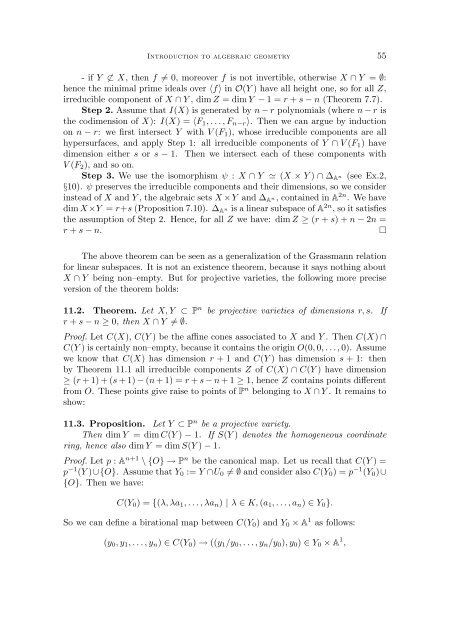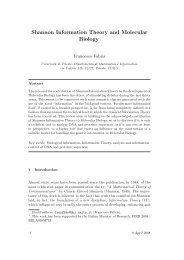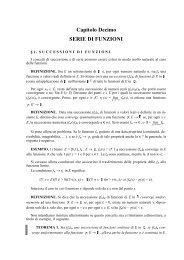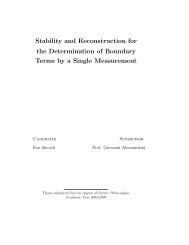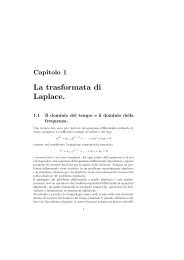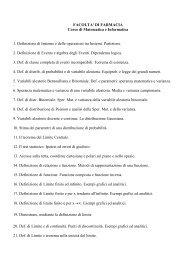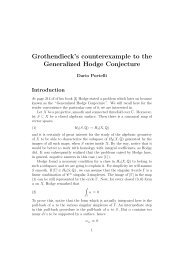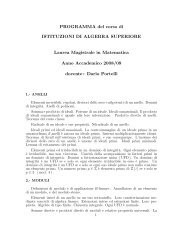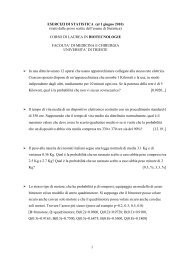INTRODUCTION TO ALGEBRAIC GEOMETRY Note del corso di ...
INTRODUCTION TO ALGEBRAIC GEOMETRY Note del corso di ...
INTRODUCTION TO ALGEBRAIC GEOMETRY Note del corso di ...
Create successful ePaper yourself
Turn your PDF publications into a flip-book with our unique Google optimized e-Paper software.
Introduction to algebraic geometry 55- if Y ⊄ X, then f ≠ 0, moreover f is not invertible, otherwise X ∩ Y = ∅:hence the minimal prime ideals over 〈f〉 in O(Y ) have all height one, so for all Z,irreducible component of X ∩ Y , <strong>di</strong>m Z = <strong>di</strong>mY − 1 = r + s − n (Theorem 7.7).Step 2. Assume that I(X) is generated by n − r polynomials (where n − r isthe co<strong>di</strong>mension of X): I(X) = 〈F 1 , . . ., F n−r 〉. Then we can argue by inductionon n − r: we first intersect Y with V (F 1 ), whose irreducible components are allhypersurfaces, and apply Step 1: all irreducible components of Y ∩ V (F 1 ) have<strong>di</strong>mension either s or s − 1. Then we intersect each of these components withV (F 2 ), and so on.Step 3. We use the isomorphism ψ : X ∩ Y ≃ (X × Y ) ∩ ∆ An (see Ex.2,§10). ψ preserves the irreducible components and their <strong>di</strong>mensions, so we considerinstead of X and Y , the algebraic sets X ×Y and ∆ A n, contained in A 2n . We have<strong>di</strong>m X ×Y = r+s (Proposition 7.10). ∆ An is a linear subspace of A 2n , so it satisfiesthe assumption of Step 2. Hence, for all Z we have: <strong>di</strong>m Z ≥ (r + s) + n − 2n =r + s − n.□The above theorem can be seen as a generalization of the Grassmann relationfor linear subspaces. It is not an existence theorem, because it says nothing aboutX ∩ Y being non–empty. But for projective varieties, the following more preciseversion of the theorem holds:11.2. Theorem. Let X, Y ⊂ P n be projective varieties of <strong>di</strong>mensions r, s. Ifr + s − n ≥ 0, then X ∩ Y ≠ ∅.Proof. Let C(X), C(Y ) be the affine cones associated to X and Y . Then C(X) ∩C(Y ) is certainly non–empty, because it contains the origin O(0, 0, . . ., 0). Assumewe know that C(X) has <strong>di</strong>mension r + 1 and C(Y ) has <strong>di</strong>mension s + 1: thenby Theorem 11.1 all irreducible components Z of C(X) ∩ C(Y ) have <strong>di</strong>mension≥ (r + 1) + (s + 1) − (n+1) = r + s − n + 1 ≥ 1, hence Z contains points <strong>di</strong>fferentfrom O. These points give raise to points of P n belonging to X ∩ Y . It remains toshow:11.3. Proposition. Let Y ⊂ P n be a projective variety.Then <strong>di</strong>m Y = <strong>di</strong>mC(Y ) − 1. If S(Y ) denotes the homogeneous coor<strong>di</strong>natering, hence also <strong>di</strong>mY = <strong>di</strong>m S(Y ) − 1.Proof. Let p : A n+1 \ {O} → P n be the canonical map. Let us recall that C(Y ) =p −1 (Y )∪{O}. Assume that Y 0 := Y ∩U 0 ≠ ∅ and consider also C(Y 0 ) = p −1 (Y 0 )∪{O}. Then we have:C(Y 0 ) = {(λ, λa 1 , . . ., λa n ) | λ ∈ K, (a 1 , . . ., a n ) ∈ Y 0 }.So we can define a birational map between C(Y 0 ) and Y 0 × A 1 as follows:(y 0 , y 1 , . . ., y n ) ∈ C(Y 0 ) → ((y 1 /y 0 , . . ., y n /y 0 ), y 0 ) ∈ Y 0 × A 1 ,


